On the outskirts of Wallan, at a location yet to be divulged – all is quiet. There’s little to see unless you’re interested in other people’s rubbish they felt necessary to dump there. Should you wait long enough a car may pass you by, but even they are scarce. So why would anybody feel compelled to stop and visit a place which has very little to offer? To best find the answer to this question one must first close their eyes and attempt to visualise themselves at the intersection of 2 old dirt roads in the country.
Suddenly, an Inn fashioned from timber appears before you and you see smoke rising from its chimney. It appears to be early morning. You catch the smell of freshly baked bread as it wafts through the air. A young horse rider gallops hastily towards you, acknowledges you with a nod of his head and passes, then dismounts and enters the Inn eagerly. Nearby, you see a general store and observe the husband and wife owners as they begin to make preparations for the new day. Their children run and play outside and their mother momentarily calls to them with a gentle warning to stay clear of the road. You hear a clanging of metal and as you look towards the sound see a blacksmith in the distance, shaping a piece of red hot piece of metal – but into what, you mind from the 21st century cannot fathom. You think you can hear a baby crying in the distance, but cannot be 100% certain.
The general store and blacksmith then fade from view, but the Inn remains. You observe that it now looks dilapidated and unused. It appears as though over ten years have passed by.
A wooden house stands beside two large gates barring the road, and beside them, some type of signboard. A horse and cart approach and its occupants hand some coins to a young gentleman through a window in the house. He proceeds to exit the house and unlocks a large padlock and unravels a metal chain which had fastened the two gates together. He opens the gates and the horse and cart pass through and continue on their journey.
You now see another traveler upon the road. He carries a pole over his shoulder, and balanced on each end are cane baskets. Intrigued, you walk towards him and he greets you in a foreign language and smiles, gesturing for you to look at the contents of the baskets; you see they are laden with vegetables. You begin speak to him, in an attempt to ask where you are, when you are, but then, just as suddenly as everything appeared, all is gone and you are again returned to your mundane life reading this article.
Momentarily, the mysterious veil which shrouds the past from today was peeled back and you were thrust 165 years into the past allowing you to witness some of the people and events from the once famous, but nearly forgotten (until now!) Tollbar Corner!
Tollbar Corner
In the mid 1850’s, the road passing through Wallan was the main route northwards towards the many goldfields in Bendigo and Beechworth, and also to Sydney. The name “Wallan Wallan” (later shortened to Wallan) is believed to be derived from an Aboriginal Wurundjeri tribe term and means “a circular place covered in rainwater” or “place of many waters” which typically describes the wet winter climate around the area.
In the early days of Wallan there was a lot of low-lying ground which was prone to developing swamps and making the main road very boggy during winter months. To avoid these boggy conditions, the heavy bullock and horse wagoners, plus the wandering mobs of stock detoured along the high and dry sandy ridge west of Wallan. Thus, a by-pass road that we know today as Old Sydney Road (formerly Old Broadmeadows Road) that later connected to the main road at the top of Pretty Sally Hill was formed.1
As this bypass was more commonly used, the junction of Stockdale Road and Old Broadmeadows Road became populated and in its prime was comprised of a hotel, a goods store, a tollbar and tollhouse, and a blacksmith. Within a 2 mile radius of Tollbar Corner, the residences of some of the pioneers of the district such as the Cummins, Stockdale, Francis, Munro and Sutherland families could be found.
Surplus butter, potatoes and any perishable foodstuffs was carted from the surrounding farms to meet the transport wagons (either bullock or horse wagons) and collected at Tollbar Corner to be taken to Melbourne or the gold fields to be sold. Unsalted butter was sold to wagoners for axle grease. Early settlement around this area began at the corner, dubbed the name “Tollbar Corner”, and so named because it was the corner of where a tollbar was constructed.
What is a Tollbar?
An article from The Argus newspaper on 28th July, 1928 best describes the background and usage of a tollbar or tollgate.
“The Roads Act of February, 1853, empowered the District Road Boards, which were the predecessors of the rural municipalities, to establish toll gates, subject to the approval of the Lieutenant-Governor. The Central Road Board, which was brought into being by the same act, was the authority which controlled the formation and maintenance of main lines of road. An amendment, passed in April, 1854, extended to the Central Road Board the privilege of establishing toll gates, which was taken advantage of without delay. Attention was only given to those highway which led to the goldfields”
So simply put, a tollbar or tollgate was a barrier placed over a track or roadside where passage was granted after paying a toll; the toll being a charge towards the maintenance of the road. Multiple images and paintings of the St Kilda Road tollgate can be found online; ones for the tollgate at TollBar Corner are non-existent. However, the below painting of the tollgate at St Kilda Road is somewhat representative of what may have existed:
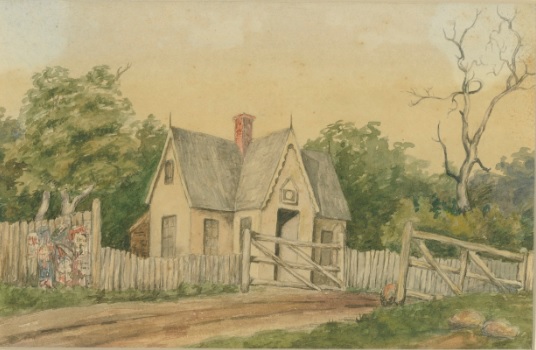
From here onwards the usage of the terms “tollbar” and “tollgate” shall be used interchangeably, and shall be regarded as one and the same.
The Cummins Family and Cummins Inn/Hotel
Bryan (also known as Brian or Bren) Cummins and his wife Margaret lived in the Parish of Bayllcahil, Tipperary. On 24th March, 1840 they boarded the ship Theresa headed for Australia and arrived at Port Phillip on 18th July, 1840. The Cummins family members on board are provided by the ship records:
Bryan Cummins
Age: 27
Occupation: Labourer
Margaret Cummins
Age: 30
Occupation: Dairymaid
Pat Cummins
Age: 9 months
John Cummins
Age: 5
Catherine Cummins
Age: 12
Also on-board were Margaret’s parents, John Sheedy and Mary Sheedy (nee Fogarty).
Bryan and Margaret had another two daughters shortly after arriving in Australia and a full record of their children is as follows:
Catherine “Kate” Cummins
Born: 1828
Died: 1850
John Patrick Cummins
Born: 1835
Died: 1916
Margaret Cummins
Born: 1836
Died: 1899
Patrick Cummins
Born: 1839
Died: 1898
Maria “Mary” Agnes Cummins
Born: 1841
Died: 1921
Alice Cummins
Born: 1845
Died: 1915
Maria and Alice were registered as being born in Moonee Ponds area so it appears the Cummins family resided in this area not long after arriving in Australia. “Bryan Cummins, near the Moonee Ponds” is mentioned in a newspaper article from 1847 which corroborates this suggestion. Margaret did not travel on the ship Theresa and instead came to Australia when she was 6 years old in 1842.
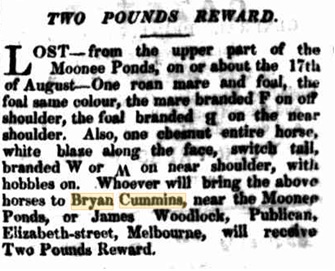
The first great development in Victoria was of a pastoral interest and millions of acres land was available for early newcomers to settle, lay claim to large areas of country, and live off the land. The Cummins family seized this opportunity around 1852 and took up an allotment of just over 1200 acres which ran west from Old Broadmeadows Road to Deep Creek at Darraweit Guim. Their land consisted of two blocks, one of 614 acres and another of 595 acres.2
It is presumed that several families presided on the Cummins property by leasing the land and surviving by providing and services to stock movers, carriers and miners on their way to gold fields further north.3
On 2nd July, 1852 an Inn/Hotel was opened which was situated on the corner of the Cummins property at the intersection of the roads known today as Stockdale Road and Old Sydney Road. The Inn/Hotel has also been described as a wine shanty but given it appears on the two maps below, it is evident it was somewhat more significant than this.
Initially known as “Cummins Hotel”, the name “Tollbar Hotel” was commonly used after the tollbar was constructed. In the newspapers the hotel was also called “DarraweitGuim tollbar”. The Inn/Hotel is also referred to as “Carriers Rest” on page 130 of the book Pretty Sally’s Hill: A History of Wallan, Wandong and Bylands – JW Payne (1981), and which shall be further discussed below. It is most likely it was constructed all from wood with chimneys made from local stone.
Pretty Sally’s Hill: A History of Wallan, Wandong and Bylands – JW Payne (1981)
It is thought that license ceased around 1866. Today, no evidence of where this Inn/Hotel stood exists except for the maps below indicating that it was on the corner of Old Sydney Road and Stockdale Road somewhere.
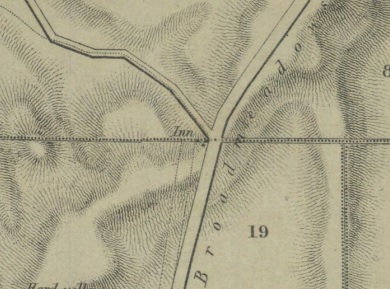
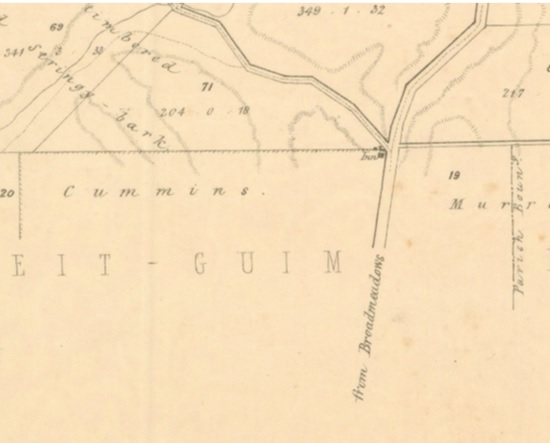
An 1856 electoral role shows that Bryan Cummins owned 1200 acres of property, and his two sons, John, aged 21 and Patrick, aged 17 owned land at 600 and 500 acres each respectively, but there is no evidence to support that John or Patrick had separate landholding from their father in 1856. It is therefore suggested that the 600 and 500 acres listed as being owned by John and Patrick were part of the 1200 acres owned by their father, being the 614 and 595 acre blocks. John and Patrick looked after the farm whilst Bryan ran the Inn/Hotel.

On 6th November, 1859 Bryan Cummins died in an accident. A newspaper article from the Kilmore Free Press newspaper in 1905 records that on 10th November, 1859 Bryan was coming to Kilmore to attend an inquest when he was thrown from his horse and killed. The inquest was in regard to the death of Denis Boulton who was killed during a drunken brawl on the Sydney road, most likely in close range of the Cummins Inn/Hotel. It is thought that Denis and also 2 others who died from this brawl are buried in the Darraweit Guim Cemetery.
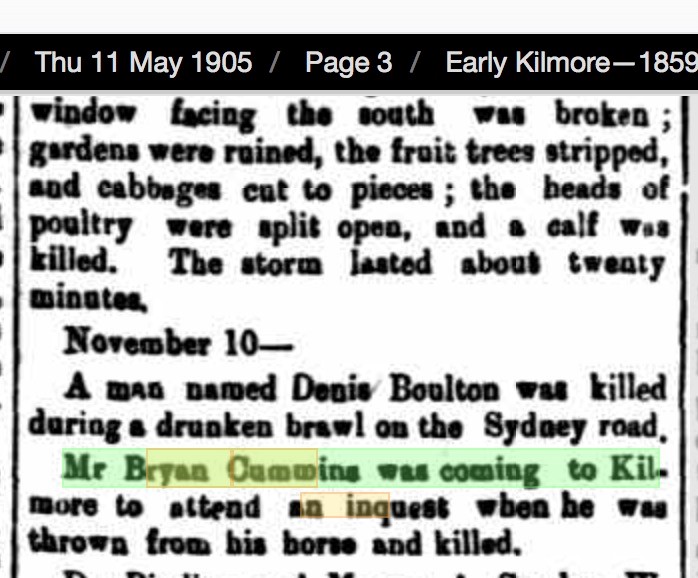
Cummins family history on ancestry.com records the following:
“The following day an inquest was held at the “Carriers Arms” hotel Kilmore and the verdict was death “by being thrown from his horse on the evening of the fifth instance near the “Carriers Arms Inn”, Wallan Wallan.”
One may note that the Cummins Inn is now referred to as “Carriers Arms” and not “Carriers Rest”. So which of these names is correct, if any? The answer appears to lie in a newspaper article from the Kilmore Free Press newspaper detailing early Kilmore in 1856 which refers to the Inn/Hotel as “Bryan Cumming’s [incorrect spelling] Carriers Rest, Deep Creek”.

After Bryan’s death the farm was left to his eldest son, John. It is interesting that John is recorded as next of kin and not his mother.
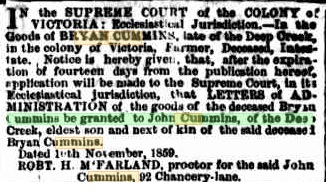
Margaret Cummins died aged 65 years at Wallan Wallan.
In the book “A life in Progress the memoirs of Rita May O’Brien 1909” we learn that that those attending school around 1915 were “Agnes, Alice, Hilda, Matt and Mark Cummins who came miles over the hills before they got to our place” and in 1930 “there were about 10 Cummins family children who lived further along the creek.” It is quite certain that these children were descendants of Bryan and Margaret Cummins.
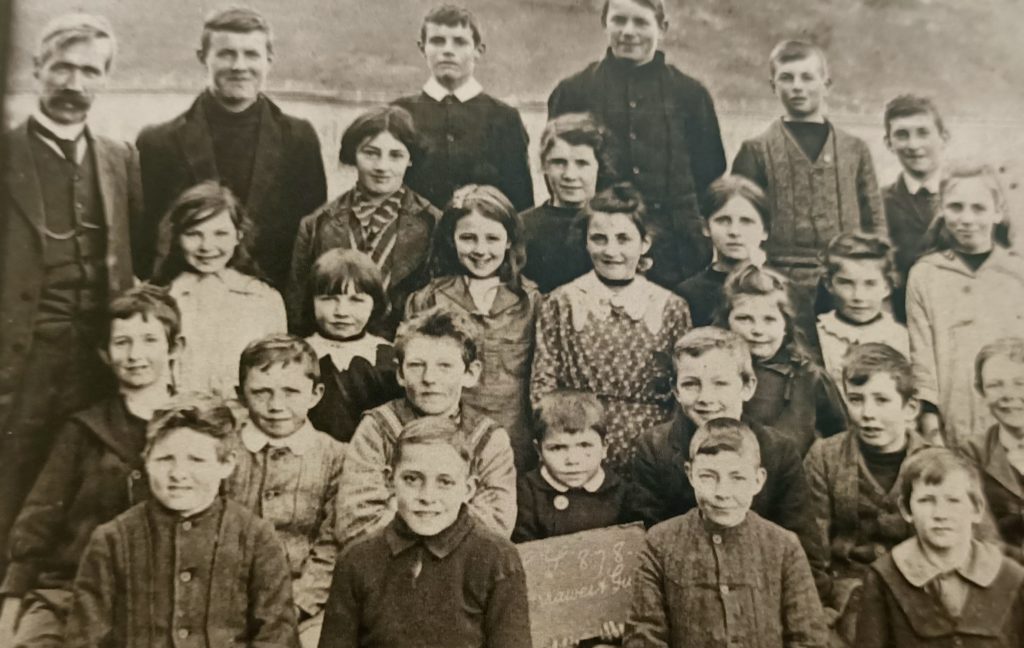
Front Row: Ben Hadfield, Mac McDonald, Billy Connor, Ray Stockdale.
2nd Row: John Stockdale, Harry Geddes, Charlie Smith, Colin McKernan, Ken McDonell, Eddie Stockdale, George Wilson.
3rd Row: Mary Connor, Netta Geddes, Vera (Bid) Cummins, Agnes Cummins, Margaret Johnston, Rita Stockdale, Alice Cummins, Bertha Smith.
4th Row: Molly Cummins, Eileen Johnston.
Back Row: Mr W. G. McKernan, Frank Cummins, Joe Johnston, Brendan Stockdale, Matthew Cummins.
The Tollbar at Tollbar Corner
No official records have been located, but it is logical that the tollbar at Tollbar Corner was constructed sometime after 1854, following the Central Roads Board being granted permission to establish tollgates on highways leading to the goldfields. Incidentally, another tollgate existed in Wallan Wallan which is recorded in the Melbourne Gazette of 1857 and 1860:

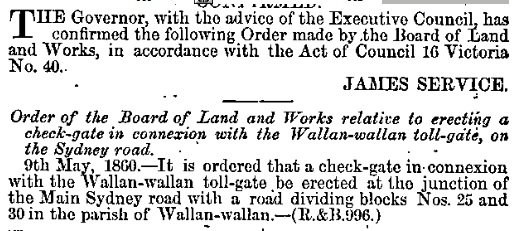
Whilst it would appear that this tollgate is the same as the one this article focuses on, it is imperative we explore in further detail to rule out the misconception that there was only one tollgate in the Wallan area.
- Records by Duncan McGregor, the district treasurer of the Road Board named the tollgate at the corner of Old Broadmeadows Road and Stockdale Road the “Darraweitguim Tollgate”. The records above are clearly for the “Wallan-wallan” toll house and gate upon Sydney Road.
- The record in the Melbourne Gazette of 1860 states “It is ordered that a check-gate in connexion with the Wallan-Wallan toll-gate be erected at the junction of the Main Sydney road with a road dividing blocks Nos. 25 and 30 in the parish of Wallan-wallan”. Block numbers 25 and 30 are beside the road known as “Sydney Road” that ran through Wallan and are not within the vicinity of the tollgate this article speaks of.
- The advertisement below seeking tender for the lease of the tollgate in 1867 clearly defines two separate tollgates: “Wallan Wallan” and “Darraweit Guim”.

The 3 points above provide conclusive evidence that the tollgates at Wallan Wallan and Darraweit Guim were not the same and can be distinguished separately from each other. Regardless, it is reasonable to believe that both tollgates existed around the same period and it can therefore be said that the tollgate at Tollbar Corner was constructed sometime between 1854 and 1857.
The Stockdale Family
Margaret Cummins worked alongside her parents at the family hotel and it was here that she caught the eye of a young gentleman by the name of William Hallett Stockdale. William was the son of Charles Jean Stockdale of Drimpton, South of Somerset in England who owned multiple estates with cottages on them and which he rented out to peasants. After he finished his studies at Bristol University in 1850, William at the age of 18 travelled to Australia by himself. He used to trade in horses and stayed with one of his mother’s relations who lived in the Melton region. They owned a big run from Melbourne right up to Beveridge.4

It has been recorded that William was out searching for lost horses when he chanced upon the Cummins Inn/Hotel and it was here where he met Margaret, they instantaneously fell in love and were married. Unfortunately, we must disappoint our readers with facts that are much less sensational. There were no fences at the time so the horses could roam anywhere and would require mustering. William was a great rider and was well skilled in mustering horses. In his search for horses he was a frequent visitor to the Cummins Inn/Hotel and over time he met and courted Margaret. They were married on 2nd July, 1857, seven years after William arrived in Australia – certainly not immediately after their initial meeting when William was searching for lost horses in the region.
Shortly after their marriage, William and Margaret purchased land west of Tollbar Corner, near Deep Creek and named it “Oakdale”. Their property ran adjacent to the “Darraweit South” or “Deep Creek” Road which was later changed to “Stockdale Road” and named after them. It seems likely that they chose this area to settle so that Margaret was close to her parents. William had no direct family members living in Australia so it made little difference to him on where they began their married life together, provided his wife was happy. It appears that she was, and they had a long and successful marriage bearing twelve (you read that right!) children5 as follows:
William Hallett Stockdale
Born: 20th June, 1858
Died:19th June, 1927
Last Resided: Wallan, Victoria
Buried: Wallan Cemetery
Catherine Stockdale
Born: 12th October, 1859
Died: 9th November 1940
Last Resided: Kilmore, Victoria
Buried: Wallan Cemetery
Ann (“Anastasia”) Stockdale
Born: 26th May, 1861
Died: 5th April 1871
Last Resided: Darraweit Guim, Victoria
Buried: Darraweit Guim Cemetery
Brian Cummins Stockdale
Born: 18th February, 1863
Died: 28th June 1940
Last Resided: “Oakdale”, Darraweit Guim, Victoria
Buried: Darraweit Guim Cemetery
Charles Jean Stockdale
Born: 1864
Died: 13th January 1956
Last Resided: Geelong, Victoria
Buried: Geelong East Cemetery
Peregrine (“Perry”) Stockdale
Born: 1866
Died: 25th January 1956
Last Resided: Darraweit Guim, Victoria
Buried: Darraweit Guim Cemetery
Margaret Stockdale
Born: 1868
Died: 8th December 1946
Last Resided: Kilmore, Victoria
Buried: Wallan Cemetery
Maryann (“Maisie”) Stockdale
Born: 1870
Died: 28th August 1948
Last Resided: Shepparton, Victoria
Buried: Shepparton Cemetery
Alice Stockdale
Born: 1874.
Died: 25th September 1918
Last Resided: Darraweit Guim, Victoria
Buried: Wallan Cemetery
Julia Stockdale
Born: 1876.
Died: 14th March 1911
Last Resided: Bylands, Victoria
Buried: Wallan Cemetery
Ellen Mary Stockdale
Born: 1879
Died: 4th January 1954
Last Resided: Albert Park, Victoria
Buried: Fawkner Cemetery
Ann Maria Stockdale
Born: 26th May, 1882
Died: 13th January 1963
Last Resided: Moonee Ponds, Victoria
Buried: Fawkner Cemetery
When Ann Maria was born, William and Margaret named her after their earlier daughter Ann Maria (Anastasia) who died of Scarlett fever at the age of 18.
Margaret passed away on 29th August, 1899 at 62 years of age and William passed away on 14th September, 1906 at 75 years of age. Both are buried in the Darraweit Guim Cemetery, but in separate sections. William was of the Church of England denomination but agreed to marry Margaret in a Catholic church given her Catholic faith and gave his blessing for Margaret to bring their children up in the Catholic Church. But because William was of Church of England he couldn’t be buried in the Catholic section of the Darraweit Guim Cemetery and instead was buried separately on his own.6
Today, such a statement may be received with shock and awe but must do well to remember that these were different times and as much as we may fantasise about living during this era, the conditions and rules imposed were not always easier or fair.
Margaret was buried with her daughter Ann (“Anastasia”) who passed away at 18.
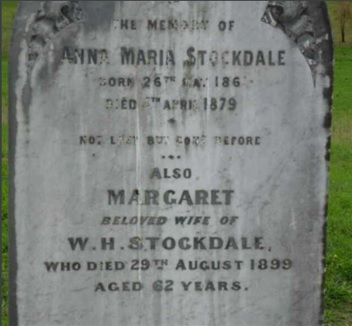
The majority of William and Margaret’s children all settled within the Darraweit Guim, Wallan and Kilmore areas and the Stockdale heritage is intertwined with many other prominent families of the region. William and Margaret’s first son, (also named William Hallet) had a son named Charles Christopher who married the youngest daughter of the son (also named William Hartley) of William Hartley Budd, owner and proprietor of the Strangeways Hotel in Wallan!
“Oakdale”, where many of the Stockdale family lived became a dairy farm in its later years and remained in the Stockdale family up until as recently as 2014, when it was eventually sold. The recreation area in the centre of Darraweit Guim is named “Stockdale Reserve”, in memory of this pioneering family.
The Francis Family
Cornelius and Mary Francis were married in 1858 and in the same year opened a general store at Tollbar Corner where they also collected the toll. It is presumed that this store was not part of the Cummins Inn/Hotel and instead a standalone structure. In 1866 they relocated to the new township of Darraweit Guim and operated the general store there. Cornelius used a two-wheeled cart to pick-up and deliver goods around the district.
In 1868 he was appointed local Postmaster and Deputy Registrar of Births and Deaths in 1869.7
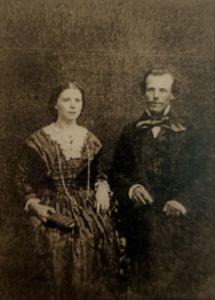
It is here where their contribution to Tollbar Corner comes to an end and one could reasonably assume this article would move on to other things. But the remainder of their story is far too interesting to exclude and it would be remiss to not provide further details.
On 8th August, 1870 Cornelius Francis was collecting firewood and crossing from west to east over Deep Creek with his horse and spring cart. The waters of the creek were swollen by a flood and began to rise sharply, yet Cornelius attempted to cross to make his way home. A witness by the name of James Stenning states that Cornelius was 2 thirds of the way across when his horse slipped from the current of the water against the spring cart. Cornelius jumped out of the cart to try and steady it but he and his horse were swept away and drowned yards downstream. Unfortunately, James Stenning was unable to swim and could not render any assistance. The body of Cornelius was not recovered until the next day and was found 200-300 yards downstream from where he attempted to cross. The witness statement of James Stenning can be viewed by clicking here.
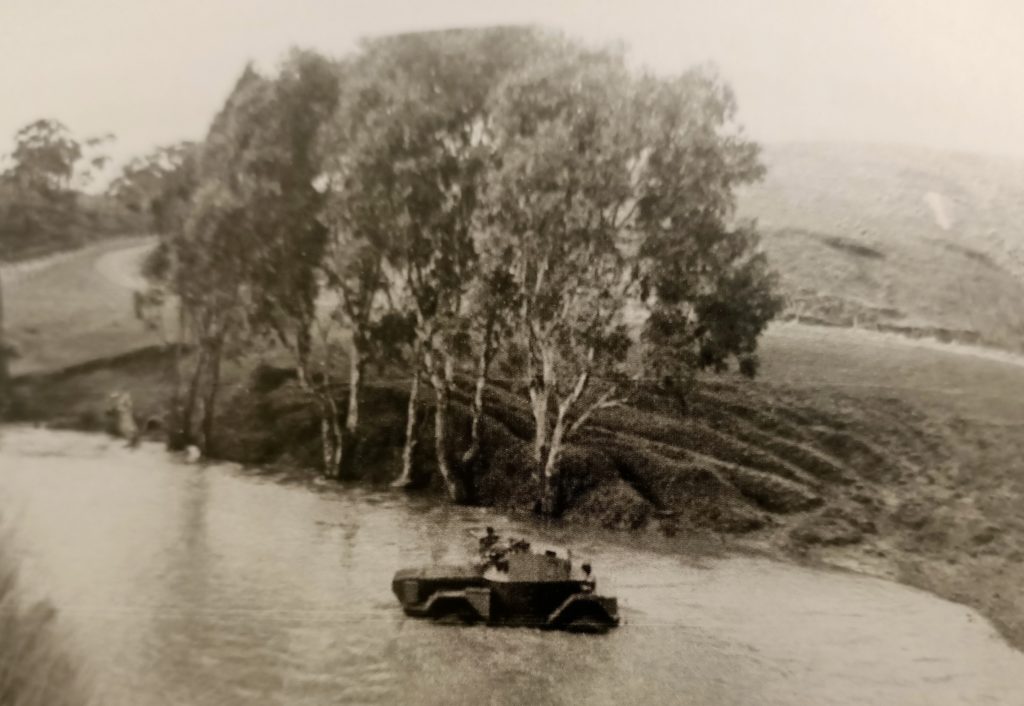
Mary Francis was therefore left widowed at the age of 31 with a family of eight children to support. In Mary’s application to have the land transferred into her name we discover the names of those eight children as follows: Annie Amelia, Elizabeth, Frederick William, Mary Ann, John Samuel, Henry James, Estel Florence and Cornelius Benjamin. The three youngest children were born after Cornelius and Mary moved to Darraweit Guim. The transfer of land document can be viewed by clicking here.
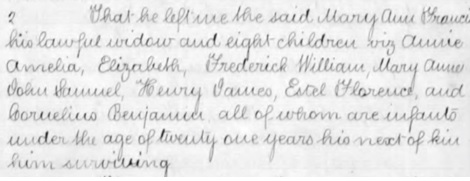
Further details of the children of the Francis family are as follows:
Annie Amelia Francis
Born: 1859
Last Resided: Kilmore, Victoria
Died: 6th May, 1951
Elizabeth (“Lizzie”) Francis
Born: 1860
Last Resided: Hampton, Victoria
Died: 8th November, 1935
Frederick William Francis
Born: 1861
Last Resided: Sandringham, Victoria
Died: 17th April, 1924
Mary Ann (“Polly”) Francis
Born: 1863
Last Resided: Hawksburn, Victoria
Died: 9th January, 1949
John Samual Francis
Born: 1865
Last Resided: Hampton, Victoria
Died: 12th August, 1936
Henry James Francis
Born: 29th October, 1866
Last Coburg, Victoria
Died: 12th December, 1942
NOTE: Records in ancestry.com use the name of ‘James Henry’ whereas the transfer of land shows the name of ‘Henry James’, as does the Francis family photo. We believe that ‘Henry James’ is the correct usage.
Estel/Ethel Florence Francis
Born: 3rd June, 1868
Last Malvern, Victoria
Died: 1956
NOTE: The transfer of land clearly shows the name of ‘Estel’ and it is believed to be in her mother’s handwriting. Later records in books and on ancestry.com use ‘Ethel’ and it may be noted in the Francis family photo that the name Ethel is also used.
Cornelius Benjamin Francis
Born: 1870
Last Tatura, Victoria
Died: 1948
Mary made the decision to carry on the family business at Darraweit Guim and was supported by her mother who looked after her children and her house. Prior to his death, Cornelius drove a horse-drawn cart to the Melbourne Market every week to trade local produce such as butter and cheese and eggs on a commission basis. He then returned with goods such as basic food items, kitchenware, farm provisions and clothing the next day to stock the store. After his passing, Mary continued this role. A neighboring bachelor and prominent figure in the district, Thomas Lade (who is mentioned in the next section) wished to marry the widowed Mary, but she resolutely rebuffed any of his advances.
She became well known and liked in the district and was sought after for advice for the treatment of sickness. She was regarded as the centre and soul of Darraweit Guim and it was only after 50 years in business that she retired to Hampton in 1917. Descendants of the Stockdale family took over the general store sometime soon after this.8
Mary passed away in 1930 at the age of 91.
The General Store at Darraweit Guim still stands today, although unused.
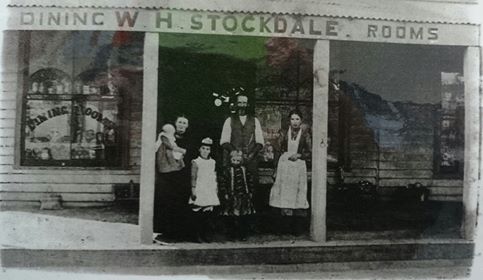


A Bridge, a Chinaman’s Garden and a Hotel
The Gold rush began in July 1851 and for a decade gold fever took hold of all communities with men leaving their employment in search for riches. It was at this time that the Chinese were imported to supply labour to replace the workforce that had fled to the goldfields. But no sooner had the Chinese commenced work than they were lured away too.
One such Chinaman was the well liked “Ah John” or” Jimmy the Chinaman” (real name Jimmy Ah Fook) who arrived in the colony during gold rush times. He did not find enough gold to ever return home and instead took up gardening on the banks of Deep Creek near McCabe’s Bridge9 built in 1866 to earn a living.
His hut was close to the Olive Branch Hotel which was run by Edward James (known as James) and Margaret McCabe and from which McCabe’s bridge was also named. James stumbled into Darraweit Guim by accident. He was a carrier on the Broadmeadows Road when his working team of bullocks got out one night and his search for them led them into the district.10
After James passed away in 1889, Margaret continued as licensee. An interesting point to note is Peregrine Stockdale, son of William Hallett Stockdale ran the hotel whilst Margaret recovered from injuries resulting from a train crash around 1900.
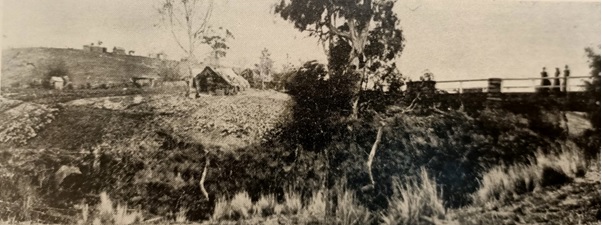
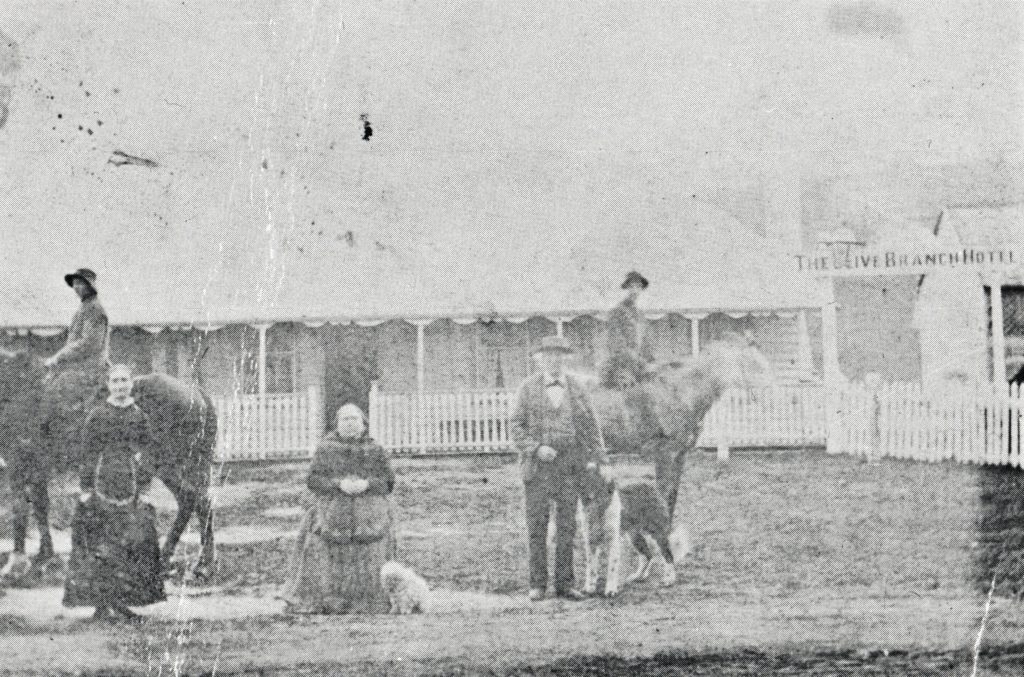
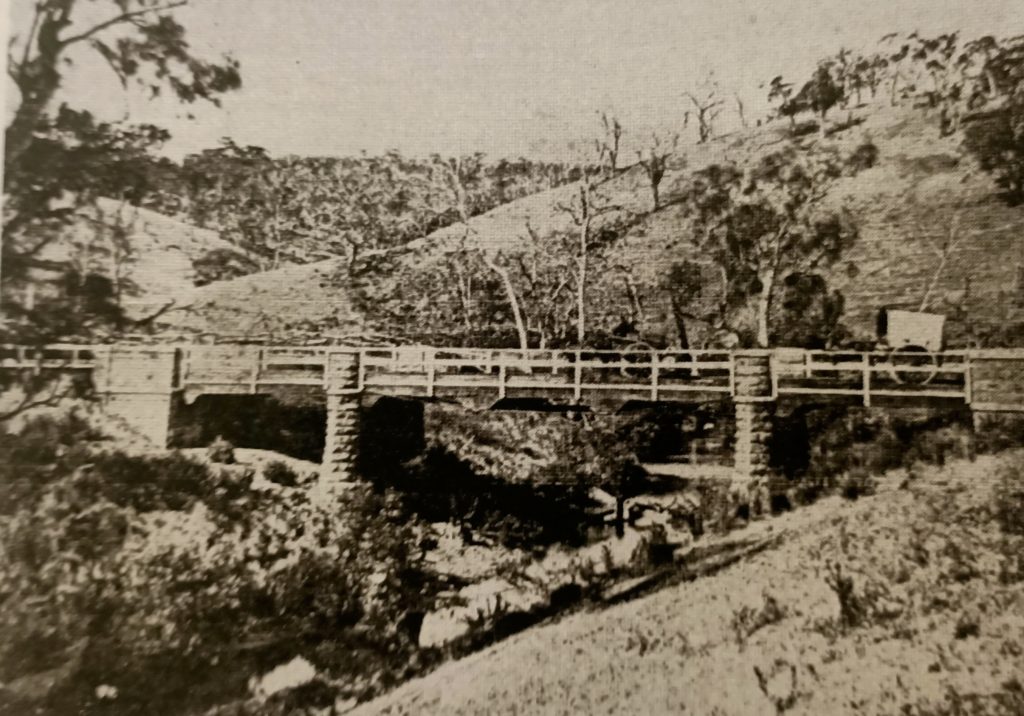

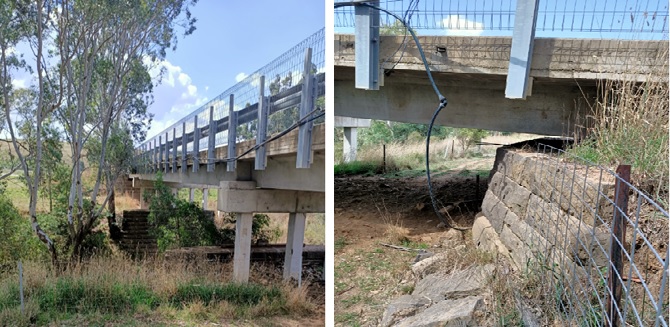
Ah John’s garden was near the road leading from Darraweit Guim to Tollbar corner and it is reasonable to assume that he sold his produce at the corner on his way to Wallan and Kilmore. He was often the only way fresh vegetables were obtained by some people and it likely his produce consisted of corn and tomatoes, lettuce, beans and peas, onions and potatoes and herbs such as parsley, mint and sage. He did not own a horse or cart so instead walked by foot and carried his produce in 2 baskets on a yoke balanced on his shoulders. It is said that that if he were unable to balance the load, he would fill the offending baskets with stones so both baskets were weighted evenly. It has also been said that if he came across any dead sheep he carried them home in his baskets, later to be used as manure for his garden. His carrying baskets were used as wool baskets in the woolshed at “Glengarry” near Darraweit Guim up until at least 1967. Given the baskets and yoke are over 110 years old one may think they no longer exist, but in August 2020 we learned that they are stored away safely on this property.
Ah John’s garden was located next to McCabe’s bridge for many years. In his later years (1900) he moved and established himself on the flat on the property of Thomas Lade on the No.3 creek11 (today known as Chinamans flat), about half way between the turnoff onto the Romsey-Wallan Rd. and the Darraweit Guim township.
He had no wife or children and passed away in May 1905 after having been ailing for some time past, and was found in his hut by Mr Lade. Later upon searching his hut £17 in single notes were found planted among some bags.
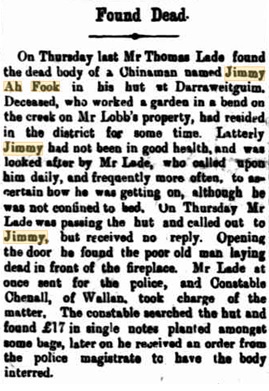
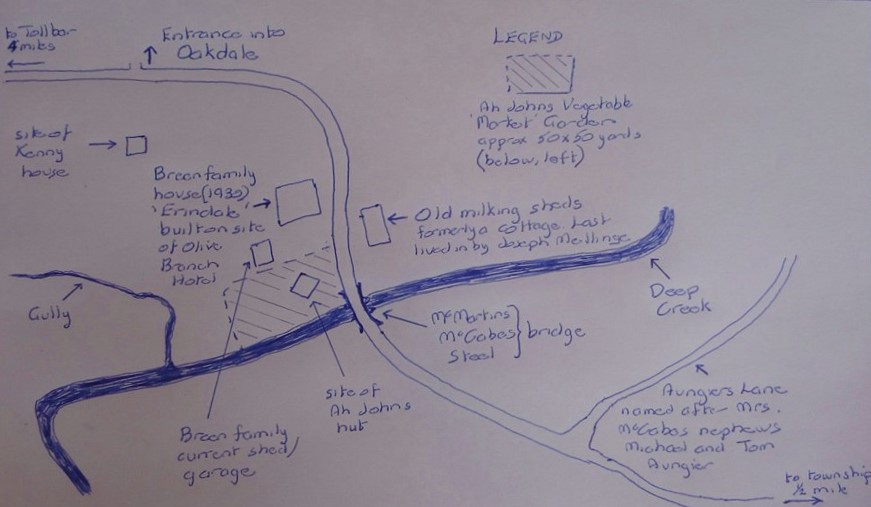
The Munro Family
In the book Pretty Sally’s Hill: A History of Wallan, Wandong and Bylands – JW Payne (1981) we learn that William Hector Munro migrated on the Wananta with the Sutherland family (whom we shall learn about in the next section) in 1852, and that an on-board romance developed between Christina Sutherland, aged 15 and William, aged 25. Due to Christina’s age they were persuaded to wait a year until her 16th birthday to become married. And on 28th June, 1853, just a few days after Christina’s 16th birthday they did just that and were married at the John Knox Church in Swanston Street, Melbourne. They remained in Melbourne for approximately 1 year before moving to the Wallan area. Christina’s brother, George was in the area at allotment 56, Parish of Wallan Wallan on the Woodstock Road around this time and his eldest child was born there by 1855.12
It is not known whether William and Christina came to the area with her brother or just shortly afterwards.
The Sutherland family history records that William, a blacksmith by trade set up a forge at Tollbar Corner settlement to assist the ever increasing number of travellers and that William and Christina had the first child, John Hector here on 14th October, 1854. Blacksmiths made a good living and there was certainly a demand for William’s services in the “shoeing” of horses and repairs to wagons and carts as they travelled towards the goldfields.
Around 1856 William and Christina moved closer to Wallan and William built a forge opposite the Green Hill where the remained for the next 16 years. In the 1870’s they moved to Wallan East and William completed several contracts during the construction of the North East railway line.13
William and Christina had 6 sons and 2 daughters as follows:
John Hector Munro
Born: 14th June, 1854
Died: 29th November, 1926
Last Resided: Perth, Western Australia
William Munro
Born: 27th September, 1856
Died: February 1857
Last Resided: Wallan, Victoria
Hugh Munro
Born: 14th June, 1866
Died: 18th August, 1943
Last Resided: Essendon, Victoria
William James Munro
Born: 8th February, 1858
Died: 28th September, 1962
Last Resided: Seymour, Victoria
Christina Margaret McNicol Munro
Born: 18th July, 1868
Died: 1944
Last Resided: Fawkner, Victoria
Charles Munro
Born: 21st March, 1871
Died: 7th February, 1969
Last Resided: North Fremantle, Western Australia
George Alexander Munro
Born: 21st June, 1873
Died: 26th September, 1963
Last Resided: Hotham, Victoria
Mary Ann Munro
Born: 13th Janary, 1875
Died: 19th June, 1968
Last Resided: Prahran, Victoria
After the depression of the 1890’s some of their children moved to Western Australia.
William died on 7th May, 1907. Christina passed away on 22nd August, 1914 and it is noted in her obituary that “she had resided in the district named since 17 years of age”. Both William and Christina are buried in the Wallan Cemetery.
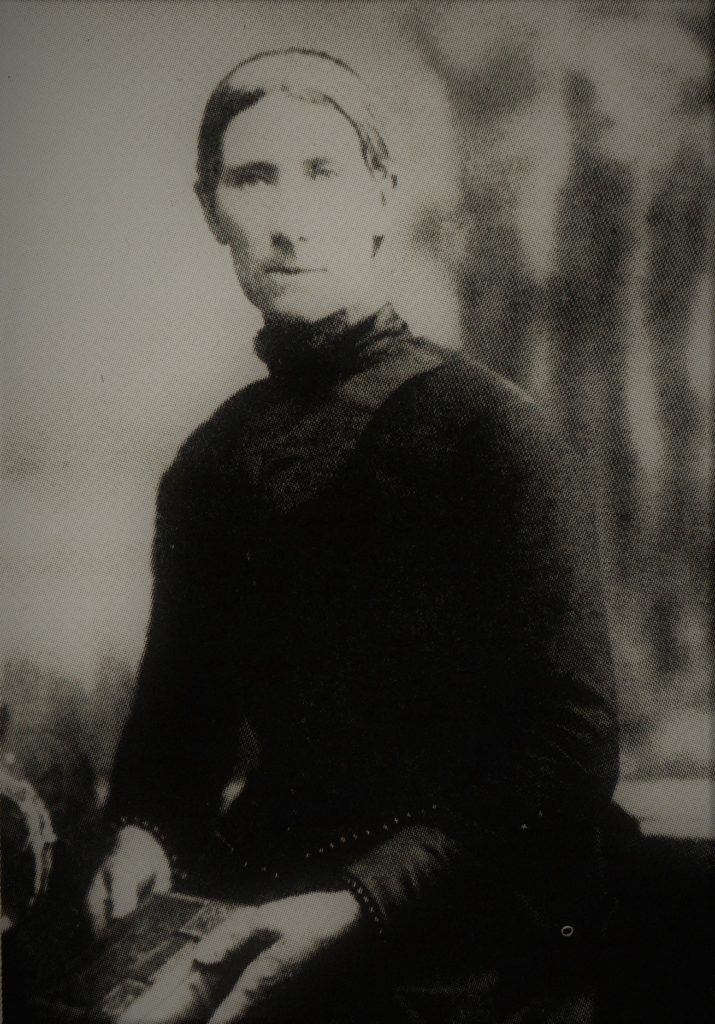
The Sutherland Family and the Tollbar
John Angus Sutherland married Mary Ann McKay and lived in Lothbeg, Sutherlandshire where he worked in his carpenter’s shop employing several men.14 In 1852, as did the Munro family, they boarded the Wananta and departed for Australia. Prior to their departure from Liverpool on 10th June, 1852 they had a family of 10 children (7 sons and 3 daughters). Their journey took 116 days and they arrived in Melbourne on 4th October, 185215 with John Angus being 50 years old and his wife Mary Anne 48 years old. Their family ranged in age from 8 to 27 years old and their 4 eldest sons were married, their wives travelling to Australia with them.
Details of the Sutherland family children are as follows:
William Sutherland
Born: 29th March, 1825
Last Resided: Essendon, Victoria
Died: 10th February, 1900
Angus Sutherland
Born: 18th January, 1827
Last Resided: Wallan, Victoria
Died: 24th October, 1859
Alexander Sutherland
Born: 9th November, 1828
Last Resided: Wallan, Victoria
Died: 28th July, 1871
George Sutherland
Born: 16th November, 1830
Last Resided: Euroa, Victoria
Died: 9th July, 1905
John Sutherland
Born: 11th December, 1832
Last Resided: Katandra, Victoria
Died: 6th February, 1924
Charles Sutherland
Born: 12th October, 1834
Last Resided: Wallan
Died: 18th May, 1866
Christina Sutherland
Born: 17th June, 1837
Last Resided: Wallan
Died: 7th May, 1907
Mary Ann Sutherland
Born: 23rd March, 1839
Last Resided: Euroa, Victoria
Died: 18th August, 1933
Janet Sutherland
Born: 25th March, 1841
Last Resided: Lothbeg, Sutherlandshire, Scotland
Died: 6th March, 1846
James Broomfield Sutherland
Born: 23rd January, 1844
Last Resided: Shepparton, Victoria
Died: 14th May, 1915
The Sutherland’s lived in Richmond for some time and it was in 1858 that John Angus and Mary Ann first bought farm land at Wallan. They purchased land from William MacLeod16 who sold them 117 and a half acres of the northern section of allotment 80, which originally consisted of 217 and a half acres.17
By this time, their daughter Margaret was living with William Munro in Wallan.
The Sutherland family lived in what was known as the “Old Square House” which was situated between 2 rows of hawthorn trees and named after their original home in Lothbeg. The house was built of red bricks with a shingle roof and the walls were white-washed inside. In 1948, only one room remained standing and weekend rabbiters who came from Melbourne via the train to Beveridge station and walked to the area found overnight accommodation in the deserted dwelling. In the 1970s, all that remained of the home was the solid bluestone base foundations, many red hand make bricks, and rubble.18
In the early 2000’s, the foundations and rubble were removed to make way for crop plantations.
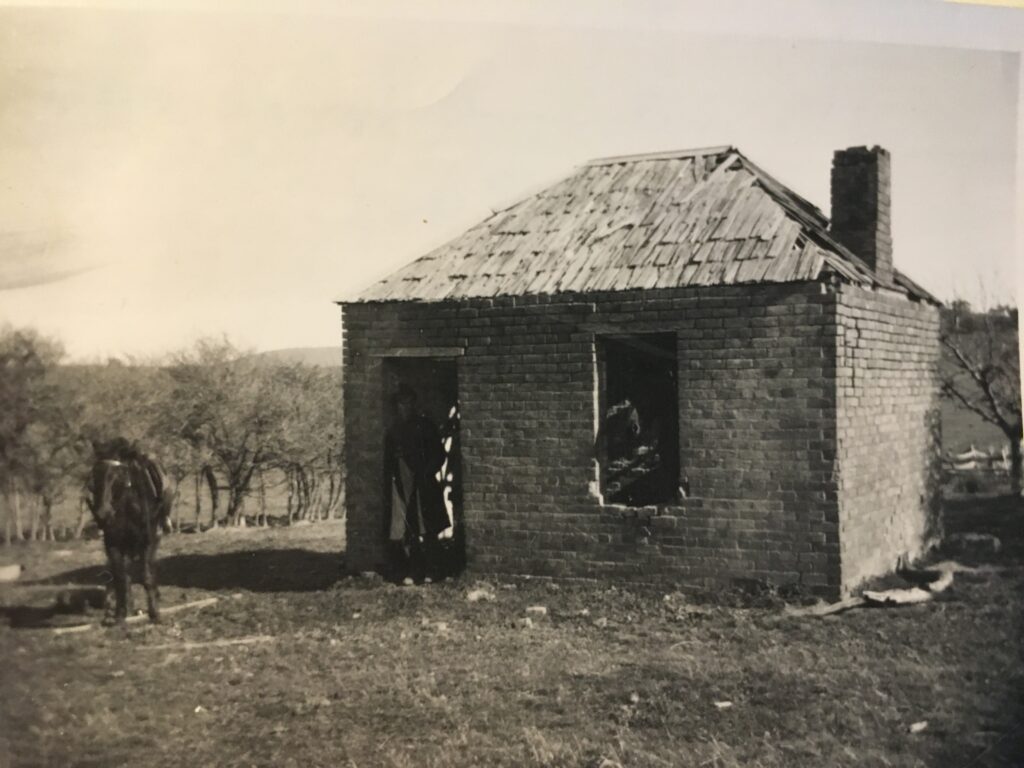
The back of the Sutherland farm adjoined the Old Broadmeadows Road, with Stockdale Road joining at the south west boundary of their property. In 1865, the lease of the tollgate was put out to tender and John Angus applied and was successful. It is presumed part of the reason for doing so was the close proximity to the family farm.
Tenders for the position of tollkeeper were called annually and John Angus only acted as tollkeeper for the year 1866. On 3rd January, 1867 a wage of 27 shillings per week was accepted from John Sutherland, the 5th son of John Angus who was unmarried at the time. A monthly tally was kept which recorded daily the stock, carts and wagons which passed through the tollgate and the amount of money collected. The tollkeeper received a wage which was paid approximately every 4 months and John’s wage totalled nearly £56 a year. For the right to operate a tollhouse a tollkeeper was required to pay rent, and in 1867 John paid £14 rent in 5 various payments.19
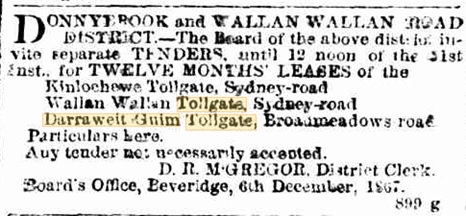
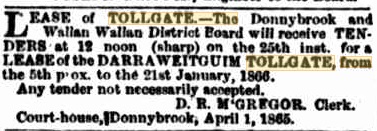
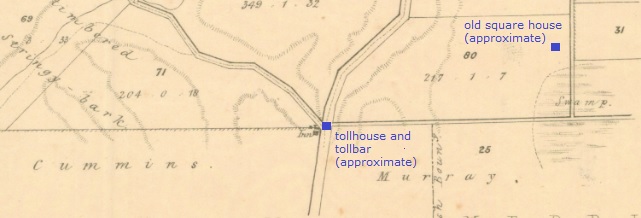
The tollgate was not originally positioned at the intersection of Old Broadmeadows Road and Stockdale Road and was located further south. In the Kilmore Examiner newspaper 1874 there is mention that John Sutherland had complained that many cattle had passed without their owners paying. As a result, council decided to move the tollgate 120 yards north to the intersection.
At some point a toll house was constructed and it is presumed it was after the location of the tollbar was shifted. A massive padlock and key were used at the tollbar.20

Very large mobs of stock often passed the tollbar, with the largest being 7200 sheep in 1870. Many horses, carts and single horses were also recorded. A large toll board listed the individual prices for various animals, carts and wagons with the prices carved in relief. The prices charged were as follows:
| Item | Charge |
|---|---|
| Horse | 3 pence |
| Cattle | 1 penny |
| Sheep | 25 for 1 shilling |
| Cart | 5 pence |
| Dray | 1 shilling to to shillings |
| Wagon | 4 shillings |
| Threshing Machine | 2 shillings and 6 pence |
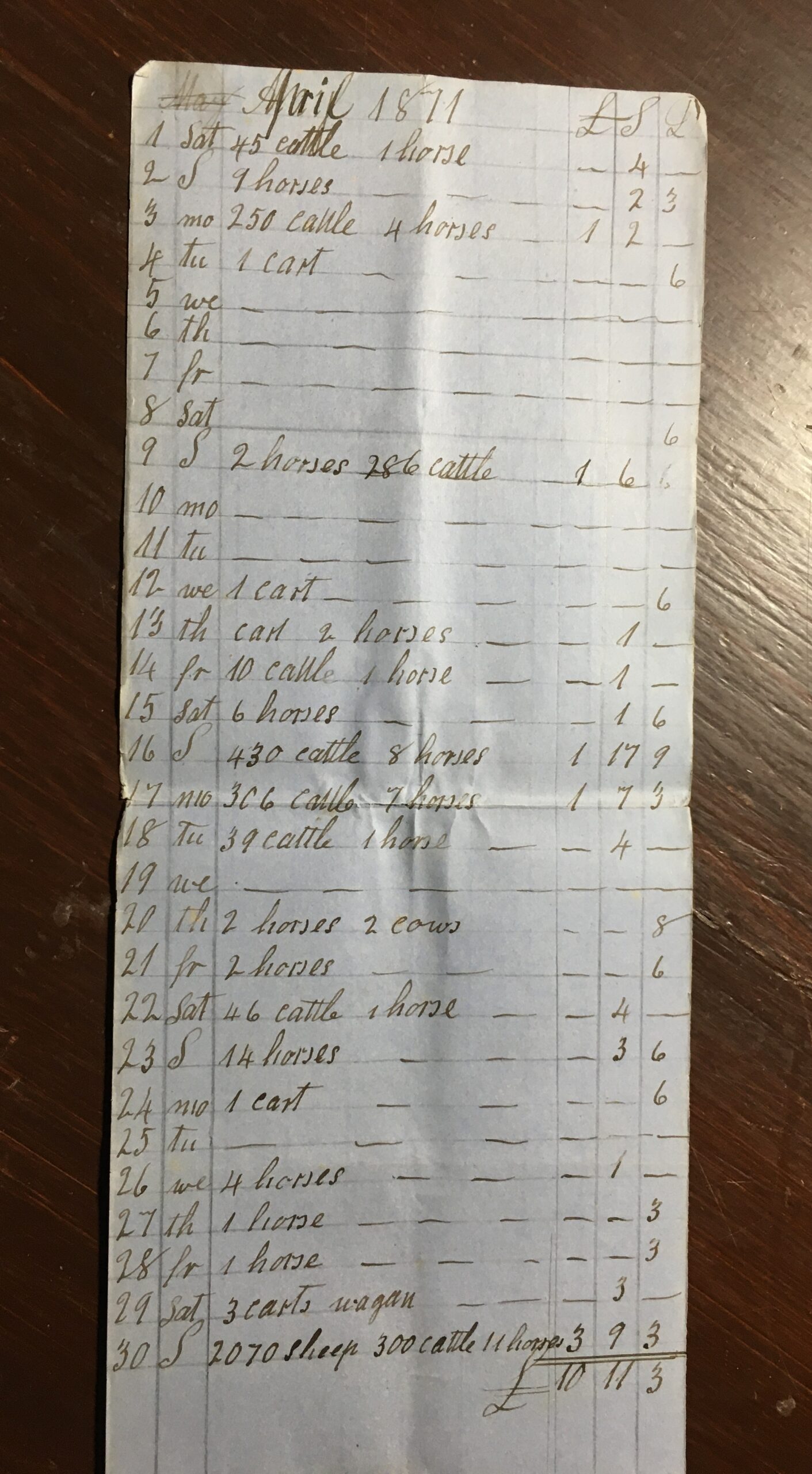
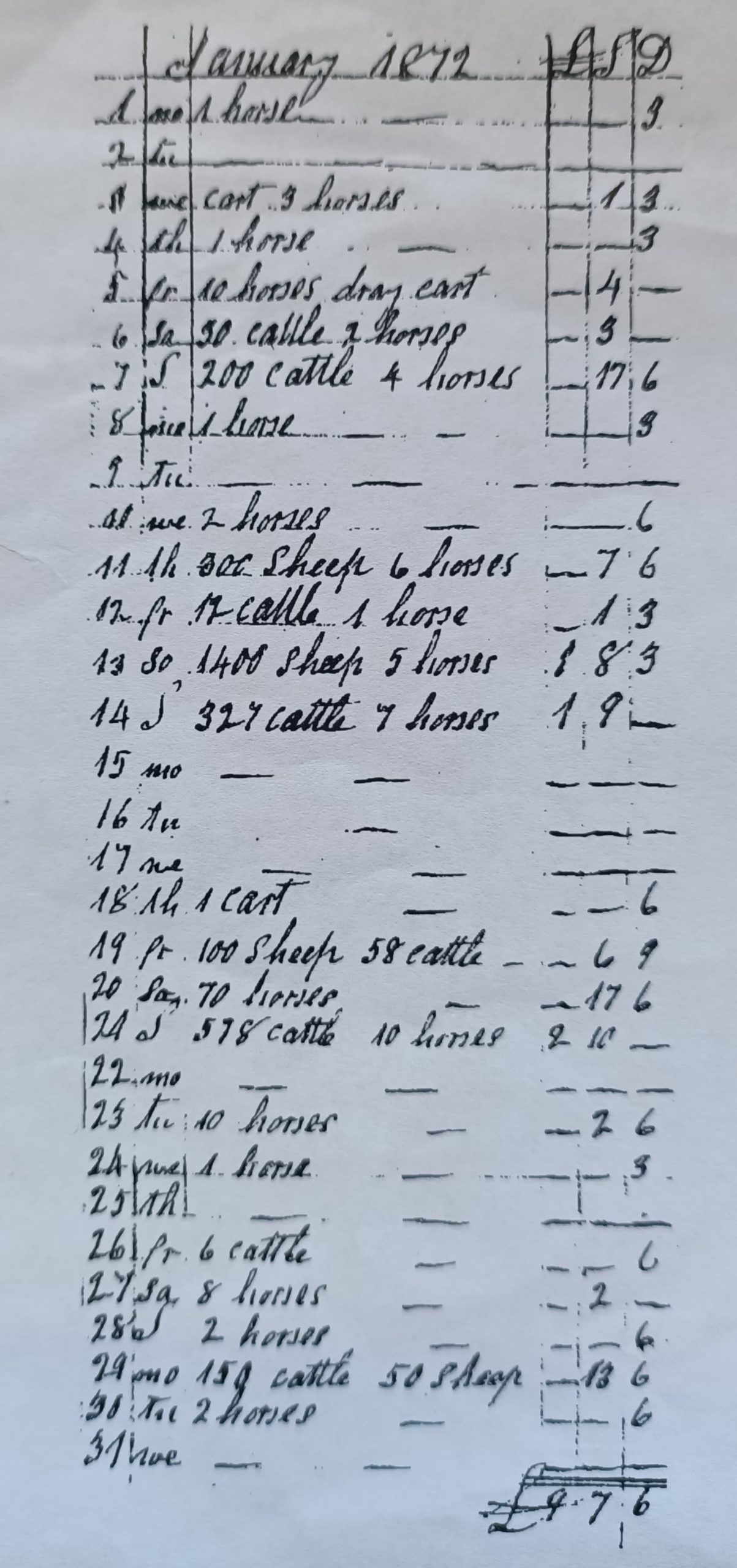
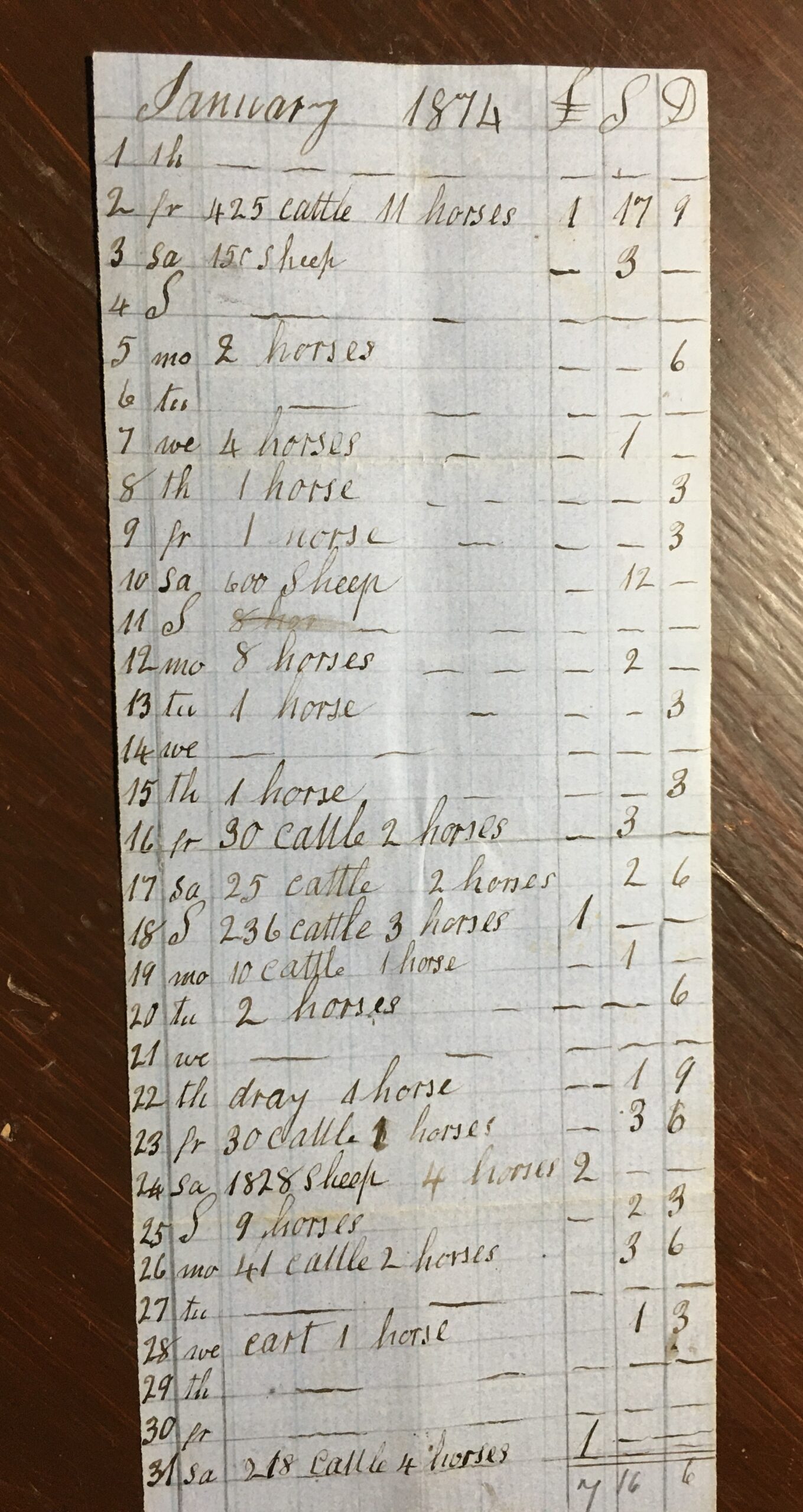
Money collected at the tollbar over the years is as follows:
| Year | Amount Collected |
|---|---|
| 1869 | £109 |
| 1870 | £100 |
| 1871 | £152 |
| 1872 | £90 |
| 1873 | £70 |
It may be noted that the amount collected in the later years had begun to dwindle and perhaps this is the reason that John Sutherland left Darraweit Guim and the tollgate in February, 1874. He moved to Nagambie where he was married.
It is thought that the tollgate ceased from the time John left and records mention that the gates were finally removed on the 20th October, 1875. One of the toll gates later hung for many years at the entrance to George Wilsons farm on Stennings Lane. The tollhouse was demolished and much of the timber of the tollhouse was used by John to helped construct his home in Nagambie and then later in Cosgrove. The timber was used in the construction of several bedrooms and several doors from the tollhouse were also used. A decorative wooden trimming from the roof of the tollhouse was also used and a large strainer post from which one of the tollgates hung was used as a post at the property’s entrance gate. The Sutherland family history records that in 1967 the toll board which listed prices was used as a door to an outbuilding, but the relief carving faced the weather and the wording was barely readable. Amazingly, the tollboard sign still exists today!
The following is a best guess of what is legible on the sign:
TOP ROW: every six horses or other animal 3s 6d
SECOND ROW: every piece? place? … or goat
THIRD ROW: horses or vehicles
BOTTOM ROW: … coach …. other such carriage
…dray in… horse or other animal…
….horse
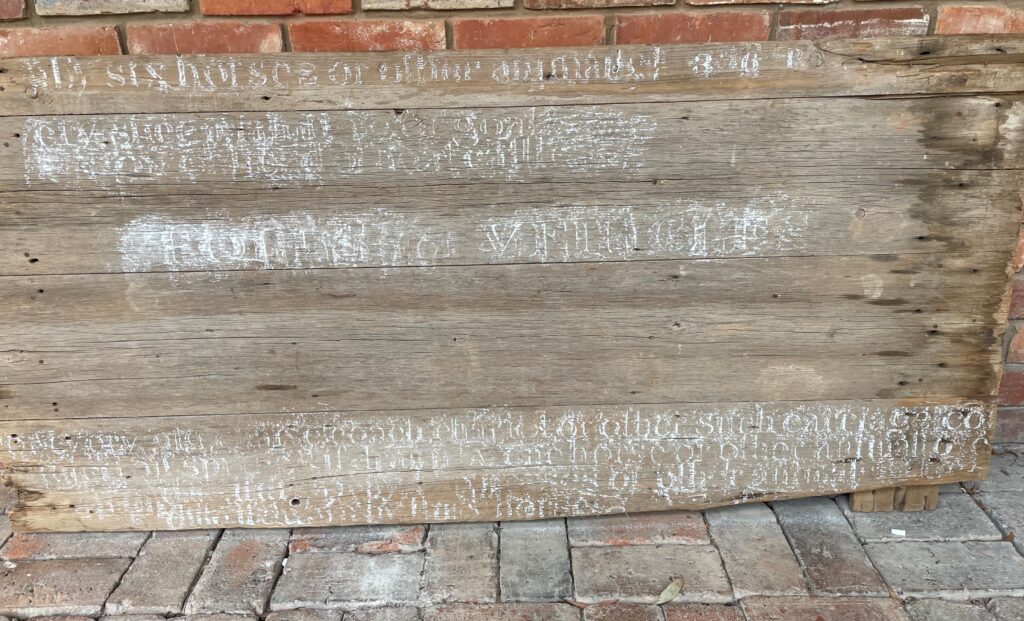
Suffering for 3 months with chronic Bronchitis, John Angus Sutherland passed away on 24th October, 1875. Nine days prior to his death on 15th October, 1875, a written document by John passed the family farm over to his youngest son, James and states:
“I John Sutherland of Wallan Wallan, in the Colony of Victoria hereby out of pure love and affection for my son, James – hereby hand over to him the paddock purchased by me from Mr MacLeod in 1858 for his sole use and benefit.”
In the late 1870’s, James who was now married with 5 children was experiencing difficulties and his older brother John became concerned about him. It appears that James left the farm in 1877 and lived with John in Nagambie for some time. On 21st April, 1878 James Sutherland sold the farm to John Laffan and it became part of the well known Inverlochy Estate.
Mary Sutherland passed away on the 1st November, 1882 at Euroa, Victoria.
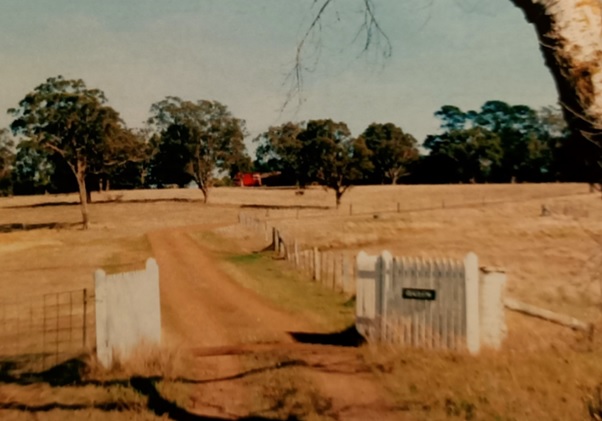
Conclusion
The Cummins, Stockdale, Munro and Sutherland families packed up their belongs in their homeland and sailed overseas to Australia for a better life. Their journey must have been filled with uncertainty, and what lay before them was unknown; but their actions were fuelled by one common human motivation: hope. From humble beginnings commencing at Tollbar Corner they became successful, and were able to make a modest living off the land around the Wallan, Darraweit Guim and surrounding areas.
Today it is difficult to imagine these people living without electricity, powered tools or telephones, but through sheer determination and “grit” they were able to endure. Farming methods were primitive and the only tools available were man-power, bullocks and horses. But they battled on with the sheer determination to succeed and with the desire to become freeholders of land. Life and homes were not filled with the creature comforts we know today and few amenities existed to cope with large families. Only home remedies existed in time of illness and those surviving from sickness were more a case of good luck than good medicine. During these times, the death of a child was commonplace. No doubt, many of their days were long and hard, some were filled with sorrow, and there is little to no evidence left of their toil and hardship.
The Cummins Inn/Hotel is long gone, its exact location unknown. Similar too is the tollhouse and tollgate; all materials have been removed and again we can only speculate on exactly where they stood. The Old Square house of the Sutherland family remained for many years but it too eventually became a victim of time as did Ah John’s hut which disappeared long ago, And of course, all these people have now gone onto their great reward.
There is immense loss and it is impossible to not feel some regret in being unable to speak with these people, or to marvel at the wonders now faded from yesteryear. But loss is an inevitable consequence of the hands of time that constantly move forward, and for which no solution currently exists. We would therefore encourage you to visit Tollbar Corner and the many other locations mentioned in this article. Upon doing so, we implore you to pause, take a moment and to remember. Surely, all will be quiet and the voices of the ghosts of the past shall remain silent – for the times, buildings, events and people mentioned in this article are now long gone.
But they certainly, certainly do not need to be forgotten.

It is our belief that this account is historically accurate and supported with factual information; we do accept there will be some differences in names and details between what is written by us compared to others. You are welcomed to leave a comment or send an email to team@oldplaces.com.au with your thoughts or any further information you may have.
Richard Cooper and Connors Roberts.
18th March 2020.
References/Notes
[1], [2], [4], [6], [8] A life in Progress the memoirs of Rita May O’Brien 1909
[3] Darraweit Guim State School No 878 Centenary 1867 – 1967
[5] http://users.ncable.net.au/~hartleyb/mrbudd1877.html
[7] The George Wilsons of Darraweit Guim – Allan G D Wilson 2014
[9] A flood in 1906 swept away the decking and the road was raised with steelwork.
[10] When memory turns the key: The history of the shire of Romsey – John Reid 1992
[11] The township of Darraweit Guim is situation on Deep creek. It is joined by many tributaries, one of which is the number 3 or Boyd’s Creek that enters Darraweit Guim.
[12], [18], [19], [20] John Angus – Mary Ann Sutherland and Descendants. 1802 – 1973 by Norma Jane Sutherland.
[13] , [14], [17] Pretty Sally’s Hill: A History of Wallan, Wandong and Bylands – JW Payne (1981)
[15] Leask’s genealogical guide to some Australian families and their antecedents and genealogies – B. Chalmers Leask
[16] William MacLeod was a very early Wallan Settler. He took up considerable property at Wallan and later built himself a large bluestone home that became known as “MacsField”
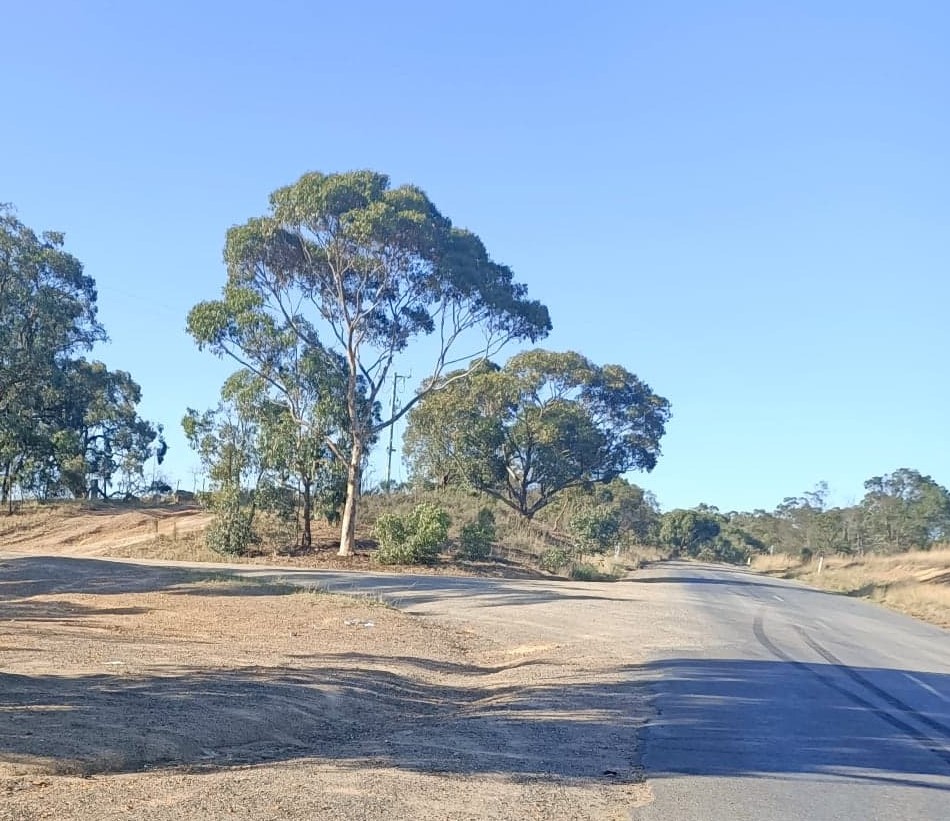


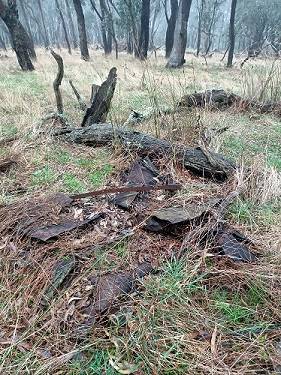

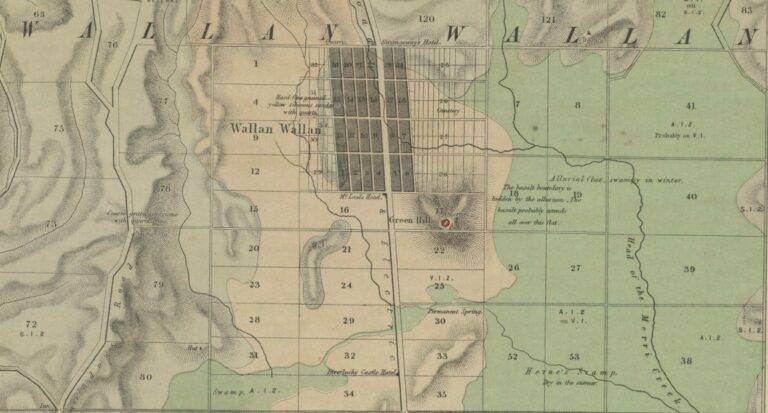
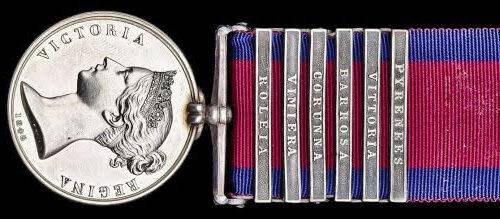



I’m intrigued, please share. Lol
Brilliant!
Congratulations on a most informative & well researched article.
Fantastic read
Really enjoyed it
I have lived in Darraweit for over 30 years and love to hear about its history
Thanks heaps
Hi
Well done Richard and Connors
The Cummins Inn was actually located in the Parish of Merriang, just outside the Parish of Wallan Wallan. In the book Pretty Sally’s Hill, Payne calls the inn Carrier’s Rest. I think I spotted you calling it Carrier’s Arms and Carrier’s Rest. There is a good story on page 130 that would be a good addition to this story. In 1863 the Donnybrook and Wallan Roads Board was created and it seems it included Darraweit Guim. Then in 1864 part of this Board was included in the Merriang Shire. I think Toll Gate collections would have then gone to these bodies, raised by this tollgate.
Also there is a reference to the Carrier’s Rest in the Kilmore Free Press on 17 May 1914
Woops it was KFP of 7 May 1914
By the way do you know who John Cummins married?
Fascinating reading and thanks for sharing
Thinking about this location further, the Inn may be in the Parish of Darraweit Guim. I tried to find an online Parish map for both Merriang and Darraweit Guim but failed. So this intersection could be where the Parishes of Darraweit Guim, Wallan Wallan and Merriage meet.
I am pretty sure that there was no such Carrier’s Rest (or Arms) Inn in Kilmore. The Kilmore Historical Society has done heaps of research on Kilmore’s pubs. Usually for the carrying out of inquests in those days they were held at the closest Inn/Hotel.
Regarding the location of the toll gate I note that in 1867 it was the Donnybrook and Wallan Wallan Roads Board called for tenders. In the partial map above the east/west border between the Roads Board and the Shire of Merriang (established 1864) appears to be across the southern part of the intersection with Stockdale Road. This, to me, is a good indication the toll gate was at the intersection just on the Roads Board side of the border as it would control traffic going along both Stockdale Road and the Old Broadmeadows Road – where the blue square is.
Thank you so much for your research.
I have been searching high and low for photos of William Stockdale, who died at Gallipoli.
Just happened to stumble across your site, and found all the photographs of him playing football in Wallan.
My husband is related to many families in the area, and we are currently doing our family trees.
You have given us a huge gift, appreciated
Hi Tamara,
Thankyou for your kind words. It’s great to hear that were able to help you out. I’ll pass on your message to Connors, who has a great wealth of knowledge on the area of football in the Wallan area. If you or your husband are on facebook and haven’t found it yet, come join the ‘Wallan Wallan Historical Group’ page. There’s some good folk on there with a lot of knowledge of Wallan history in general. The link is as follows: https://www.facebook.com/groups/wallanhistoricalgroup/
regards, Richard
Hi Tamara, I looked into William a few years ago. This is what I found on him. His brothers also joined but luckily came home. His cousin Clarence Stockdale (my grans Sarah stockdale, eldest brother) also served in WW1. Im not sure if you have already explored these links. Take care.
https://www.awm.gov.au/collection/R1660821
https://www.aif.adfa.edu.au/showPerson?pid=289401
https://vwma.org.au/explore/people/159371
http://users.ncable.net.au/~hartleyb/mrbudd1877.html
http://fffaif.org.au/wp-content/uploads/2014/11/Krithia-Proposal-for-recovery-of-Diggers-11-11-2011-abridged.pdf
https://www.awm.gov.au/collection/E1238
https://www.awm.gov.au/collection/C2105901
https://recordsearch.naa.gov.au/SearchNRetrieve/Interface/DetailsReports/ItemDetail.aspx?Barcode=8092374&isAv=N
My name is Duncan McDonell and my family has lived in Darraweit Guim since 1861 so many of your insights of district are familiar.
aho baskets are still in our possession as well as shoulder yoke,,!!Re tollgates at Ruglen( Wilsons farm) were burnt in the 1969 fire however when Wilson’s sold
Ruglen they left the hinges and gudjes of the gate to my family
Please contact as l have many memories of history of Darraweit Guim
Thankyou for this information Duncan. It was fantastic speaking with you.
To correct Rita May O’Brien 1909 ‘s idea of Margaret nee Sheedy Cummins’s parents being on the “Theresa ” in 1840 is … these were John 28 yrs & Mary Sheedy 22yrs … Mary was Mary Fogarty and they were and they had 2 children bap in Moonee Ponds, and other children in the upper yarra area. John may have been a brother or cousin but not Margaret (Sheedy) Cummins’ parent. Bryan & Margaret’s daughter, Margaret aged 3 was also not on the ship and according to Brendan Stockdale came when she was about 6 yrs of age… but years of searching have not found the arrival of the correct Margaret Cummins who was my Great Grandmother. All the best.
Thankyou for this information Andrea. I shall review and update the article accordingly.
Thank you for giving me a new insight into my family- the Sutherlands
Thanks for the story.
Peregrine Stockdale was my great grandfather. Sarah Stockdale Cleve (Sadie) m to Jack Cleve, was my Gran (daughter of Peregrine & Bridget Stockdale).
Correction Vera (Bid) – her name was Veronica.
I went to Darraweit Guim Primary school 1981 – 1985.
Thank you for your interesting story and the history behind the families. I am a Sutherland. My grandfather was John “Calrossie”Sutherland.
Thanks alot for this information, great read, we have lived in Darraweit Guim for 34 years right next door to the old store, love reading about the history of Darraweit Guim thanks again.